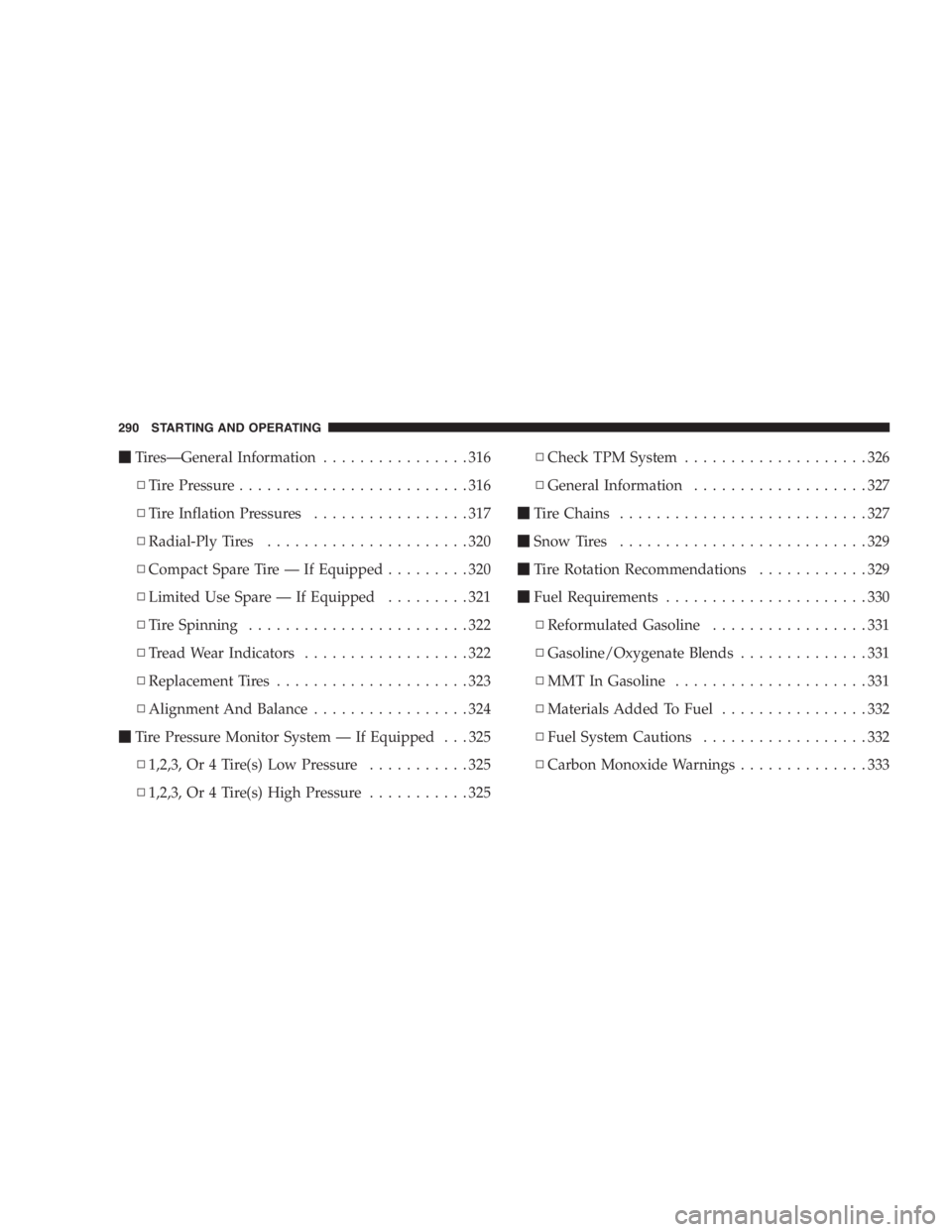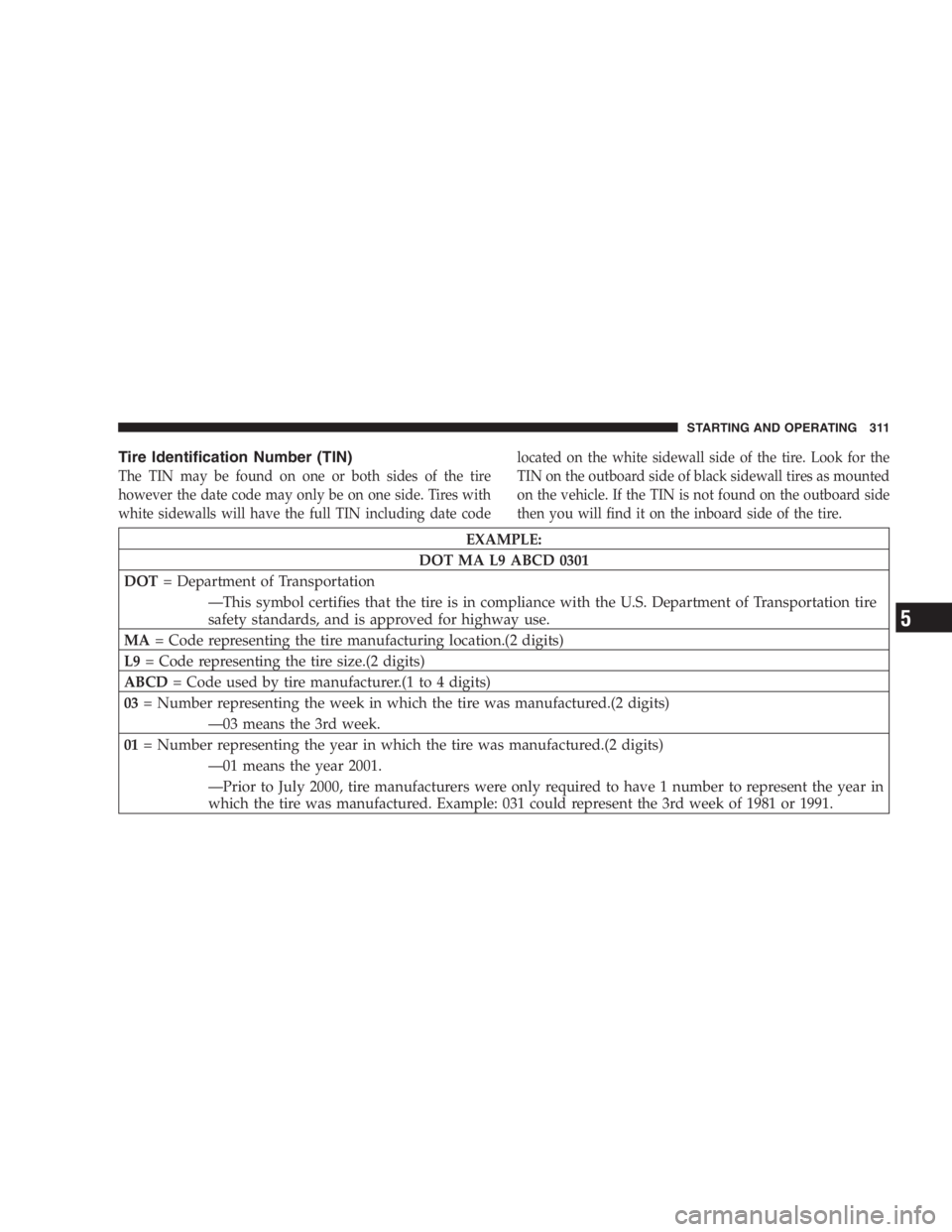Page 85 of 480
Periodic Safety Checks You Should Make Outside
The Vehicle
Tires
Examine tires for excessive tread wear or uneven wear
patterns. Check for stones, nails, glass, or other objects
lodged in the tread. Inspect tread and sidewall for cuts or
cracks. Check wheel nuts for tightness, and tires (includ-
ing spare) for proper pressure. Lights
Have someone observe the operation of exterior lights
while you work the controls. Check turn signal and high
beam indicator lights on the instrument panel.
Fluid Leaks
Check area under vehicle after overnight parking for fuel,
engine coolant, oil or other fluid leaks. Also, if gasoline
fumes are detected or fuel, power steering fluid or brake
fluid leaks are suspected, the cause should be located and
corrected immediately. THINGS TO KNOW BEFORE STARTING YOUR VEHICLE 85
2
Page 196 of 480

INSTRUMENT CLUSTER DESCRIPTIONS
1. Fuel Gauge
The pointer shows the level of fuel in the fuel tank when
the ignition switch is in the ON position.
2. Tire Pressure Monitor Warning Light — If Equipped
This light will turn on when there is a Low tire
pressure condition. The light will remain on
until the tire pressure is properly set. The light
will also flash if a problem exist with any tire
sensor. The light will flash for approximately three sec-
onds every 10 minutes or until the problem with the
sensor is corrected.
This light will turn on momentarily as a bulb check when
the engine is started.
When the tire pressure monitoring system warning light
is lit, one or more of your tires is significantly underin-
flated. You should stop and check your tires as soon as possible, and inflate them to the proper pressure as
indicated on the tire and loading information placard.
Driving on a significantly underinflated tire causes the
tire to overheat and can lead to tire failure. Underinfla-
tion also reduces fuel efficiency and tire tread life, and
may affect the vehicle ’ s handling and stopping ability.
Each tire, including the spare, should be checked
monthly when cold and set to the recommended inflation
pressure as specified in the tire and loading information
placard and owner ’ s manual.
NOTE: If one of the vehicle active tires has been
replaced by the spare or a wheel rim not equipped with
a TPM sensor, the tire pressure monitor warning light
will flash for approximately three seconds every 10
minutes. Repair or replace the tire or sensor as soon as
possible.196 UNDERSTANDING YOUR INSTRUMENT PANEL
Page 290 of 480

� Ti re s — General Information ................316
▫ Tire Pressure .........................316
▫ Tire Inflation Pressures .................317
▫ Radial-Ply Tires ......................320
▫ Compact Spare Tire — If Equipped .........320
▫ Limited Use Spare — If Equipped .........321
▫ Tire Spinning ........................322
▫ Tread Wear Indicators ..................322
▫ Replacement Tires .....................323
▫ Alignment And Balance .................324
� Tire Pressure Monitor System — If Equipped . . . 325
▫ 1,2,3, Or 4 Tire(s) Low Pressure ...........325
▫ 1,2,3, Or 4 Tire(s) High Pressure ...........325 ▫ Check TPM System ....................326
▫ General Information ...................327
� Tire Chains ...........................327
� Snow Tires ...........................329
� Tire Rotation Recommendations ............329
� Fuel Requirements ......................330
▫ Reformulated Gasoline .................331
▫ Gasoline/Oxygenate Blends ..............331
▫ MMT In Gasoline .....................331
▫ Materials Added To Fuel ................332
▫ Fuel System Cautions ..................332
▫ Carbon Monoxide Warnings ..............333290 STARTING AND OPERATING
Page 305 of 480

WARNING!• Anti-lock system (ABS) cannot prevent the natu-
ral laws of physics from acting on the vehicle, nor
can it increase braking or steering efficiency be-
yond that afforded by the condition of the vehicle
brakes and tires or the traction afforded.
• The ABS cannot prevent accidents, including
those resulting from excessive speed in turns,
following another vehicle too closely, or hydro-
planing. Only a safe, attentive, and skillful driver
can prevent accidents.
• The capabilities of an ABS equipped vehicle must
never be exploited in a reckless or dangerous
manner which could jeopardize the user ’ s safety
or the safety of others. All vehicle wheels and tires must be the same size and
type and tires must be properly inflated to produce
accurate signals for the computer.
POWER STEERING
The standard power steering system will give you good
vehicle response and increased ease of maneuverability
in tight spaces. The system will provide mechanical
steering capability if power assist is lost.
If for some reason, the power assist is interrupted, it will
still be possible to steer your vehicle. Under these condi-
tions you will observe a substantial increase in steering
effort, especially at very low vehicle speeds and during
parking maneuvers.
NOTE: Increased noise levels at the end of the steering
wheel travel are considered normal and does not indicate
that there is a problem with the power steering system. STARTING AND OPERATING 305
5
Page 308 of 480

TIRE SAFETY INFORMATION
Tire Markings
NOTE:
• P(Passenger)-Metric tire sizing is based on U.S. design
standards. P-Metric tires have the letter “ P ” molded
into the sidewall preceding the size designation. Ex-
ample: P215/65R15 95H. • European Metric tire sizing is based on European
design standards. Tires designed to this standard have
the tire size molded into the sidewall beginning with
the section width. The letter � P � is absent from this tire
size designation. Example: 215/65R15 96H
• LT(Light Truck)-Metric tire sizing is based on U.S.
design standards. The size designation for LT-Metric
tires is the same as for P-Metric tires except for the
letters “ LT ” that are molded into the sidewall preced-
ing the size designation. Example: LT235/85R16.
• Temporary Spare tires are high pressure compact
spares designed for temporary emergency use only.
Tires designed to this standard have the letter “ T ”
molded into the sidewall preceding the size designa-
tion. Example: T145/80D18 103M.
• High Flotation tire sizing is based on U.S. design
standards and begins with the tire diameter molded
into the sidewall. Example: 31x10.5 R15 LT.308 STARTING AND OPERATING
Page 311 of 480

Tire Identification Number (TIN)
The TIN may be found on one or both sides of the tire
however the date code may only be on one side. Tires with
white sidewalls will have the full TIN including date code located on the white sidewall side of the tire. Look for the
TIN on the outboard side of black sidewall tires as mounted
on the vehicle. If the TIN is not found on the outboard side
then you will find it on the inboard side of the tire.
EXAMPLE:
DOT MA L9 ABCD 0301
DOT = Department of Transportation
— This symbol certifies that the tire is in compliance with the U.S. Department of Transportation tire
safety standards, and is approved for highway use.
MA = Code representing the tire manufacturing location.(2 digits)
L9 = Code representing the tire size.(2 digits)
ABCD = Code used by tire manufacturer.(1 to 4 digits)
03 = Number representing the week in which the tire was manufactured.(2 digits)
— 03 means the 3rd week.
01 = Number representing the year in which the tire was manufactured.(2 digits)
— 01 means the year 2001.
— Prior to July 2000, tire manufacturers were only required to have 1 number to represent the year in
which the tire was manufactured. Example: 031 could represent the 3rd week of 1981 or 1991. STARTING AND OPERATING 311
5
Page 313 of 480

Tire and Loading Information Placard
This placard tells you important information about the,
1) number of people that can be carried in the vehicle
2) the total weight your vehicle can carry
3) the tire size designed for your vehicle 4) the cold tire inflation pressures for the front, rear
and spare tires.
Loading
The vehicle maximum load on the tire must not exceed the
load carrying capacity of the tire on your vehicle. You will
not exceed the tire ’ s load carrying capacity if you adhere to
the loading conditions, tire size and cold tire inflation
pressures specified on the Tire and Loading Information
placard and the Vehicle Loading section of this manual.
NOTE: Under a maximum loaded vehicle condition,
gross axle weight ratings (GAWR ’ s) for the front and rear
axles must not be exceeded. For further information on
GAWR ’ s, vehicle loading and trailer towing, see the
Vehicle Loading section of this manual.
To determine the maximum loading conditions of your
vehicle, locate the statement “ The combined weight of
occupants and cargo should never exceed XXX kg or XXX
lbs. ” on the Tire and Loading Information placard. TheTire and Loading Information STARTING AND OPERATING 313
5
Page 316 of 480

WARNING!Overloading of your tires is dangerous. Overloading
can cause tire failure, affect vehicle handling, and
increase your stopping distance. Use tires of the
recommended load capacity for your vehicle. Never
overload them.
TIRES — GENERAL INFORMATION
Tire Pressure
Proper tire inflation pressure is essential to the safe and
satisfactory operation of your vehicle. Three primary
areas are affected by improper tire pressure: 1. Safety —
WARNING! Improperly inflated tires are dangerous and can cause
accidents.
• Under inflation increases tire flexing and can result in
tire failure.
• Over inflation reduces a tire ’ s ability to cushion shock.
Objects on the road and chuck holes can cause damage that
results in tire failure.
• Unequal tire pressures can cause steering problems. You
could lose control of your vehicle.
• Over inflated or under inflated tires can affect vehicle
handling and can fail suddenly, resulting in loss of vehicle
control.
• Unequal tire pressures from one side of the vehicle to the
other can cause the vehicle to drift to the right or left.
Always drive with each tire inflated to the recommended
cold tire inflation pressure.316 STARTING AND OPERATING